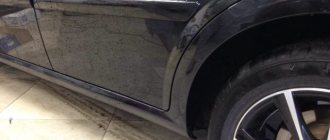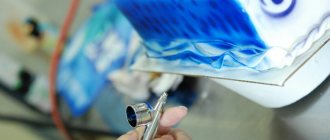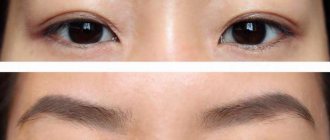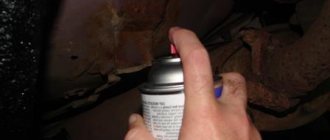Removable silicone tint based on a static film is becoming increasingly popular among car owners. Darkening the windows in this way allows you to give the car a more impressive appearance. The tint material can be removed at any time. The film can be rolled or rolled without loss of quality. It can also be reinstalled on the car windows at any time, which is very convenient.
The silicone film can be removed and reapplied many times. At the same time, it is not subject to deformation and does not lose any performance characteristics. After the next installation, the film should be thoroughly dried. This is necessary so that the tint acquires the necessary transparency. If the installation is done correctly, the car owner need not be afraid of fines from the traffic police or any other problems.
Features of removable silicone tint
Darkening car windows with silicone film looks more aesthetically pleasing. In appearance, this material is no different from ordinary film. The product can withstand any frost well. During installation/disassembly, the silicone tint film is not deformed and is not subject to mechanical stress. It is durable and practical. Removable silicone tint also does not transmit ultraviolet radiation and does not lose quality due to exposure to direct sunlight.
Using this material, you can reliably protect the car interior, as well as the people in it, from the sun's rays. In this case, normal illumination will not be disrupted. The film absorbs the glare of the sun, thereby eliminating the effects of mirrors and glare from the headlights of oncoming or passing cars.
Features of installing double glass tinting
In order for double glazing to work properly, you need to place a second window regulator and a second guide frame in the door cavity, along which the tinted glass will slide.
Naturally, you will need to add an additional button to the control. In a high-quality design, the two glasses do not come into contact with each other, do not rub against each other and do not interfere with the operation of each mechanism.
Both foreign cars and almost all VAZ models have the ability to install additional double-glazed windows. All work can be carried out at specialized car service centers.
For those who want to carry out modernization with the help of specialists, there are some tips:
Protective function
In car accidents, side and rear windows often break and shatter into small pieces. These fragments can be quite dangerous to humans. If removable silicone tinting is installed on car windows, the glass will not crumble as a result of an accident or because of stones flying out from under the wheels of oncoming cars. Even if for some reason it breaks, its fragments will not scatter in all directions. All of them will be held on film.
Automatic tinting (double glazing)
Automatic tinting (double glazing) is a progressive technology that allows you to have standard non-tinted windows on your car, and, if necessary, provide automatic tinting of the car windows at the touch of a button, in just a few seconds.
Additional tinted windows and additional power windows are installed in the front doors of the car. The window regulators operate independently, the entire system operates from standard buttons via a toggle switch (modes can be changed at the touch of a button).
Features of silicone films
Silicone tinting has a lot of positive qualities and features. Thus, the so-called static attraction is used as a fixative. There is no need for special adhesives for installation. The material can be glued and removed at least five thousand times. Even experienced professionals will not be able to tell the difference between high-quality removable and regular tinting.
Initially, these types of films were used on glass in residential buildings and offices. It is worth noting that the material itself is in no way protected from scratches. Therefore, silicone tinting is more vulnerable in this regard than other hard-based materials.
Installation Tips
Car owners often cover the rear window with a regular film, and install removable silicone tint on the front windows.
With this approach, for maximum aesthetics and matching tones, it is necessary to follow the proportions below and use materials of certain brands:
- If a slight darkening of the interior is required, a Creative product is installed on the front windows by 20%, and a film from the manufacturer Llumar ATR is used on the rear windows by 15%.
- To darken the windows in the car interior as much as possible, you need to use Creative tint material on the front windows, but at 35%. As for the remaining windows, they are tinted with Llumar Bronze by 20%.
The use of the schemes discussed above ensures an aesthetic appearance, excellent visibility and the highest level of comfort in the cabin.
Benefits of silicone tint
After analyzing the positive characteristics of this material, you can see its most important advantages. Thus, a one-way visibility effect is created, which provides fairly high confidentiality. The film increases the level of safety and reliability of auto glass.
With the help of this tinting material, the upholstery and interior elements are protected from fading in the sun. The film is resistant to ultraviolet radiation. Also among the main advantages is the possibility of its repeated use.
Silicone static tint is the most effective and high-quality material among other removable types of films. It does not change its shape and properties at any temperature. The material is not subject to rubbing and can withstand the mechanical effects of sand and dust. Having minimal skills in working with films, you can apply it to glass yourself.
It only takes a few seconds to remove tinting from glass. This is convenient in various situations (for example, if you need to cross a border). The laws of some countries prohibit driving cars with tinted windows. You can remove the film right before moving, and install it after passing through the control zone.
2 Independent work - how to install a second glass?
The new method involves installing additional tinted glass. It will lower and rise parallel to the factory-installed glass. The entire installation algorithm looks like this:
First, you must go to the store to buy a set of glasses for your car model. In addition to them, you will also need a set of electric lifts. Drivers who have already darkened their windows in this way are advised to purchase a used door of the corresponding car model and try to disassemble it first, and only then the door from your car. You must clearly know how the window lift mechanism works in your car. After this, you need to shorten the shaft designed to lower the windows. Then install the power window for the second window. On the latter you need to apply a tint film.
Do this from the outside, not the inside. After this, install the tinted glass behind the main one and connect the lift to it. Next, assemble the device for lowering the first window. At the very edge of the darkened window you need to glue a narrow protective strip. It will prevent the glasses from “driving” and rubbing against each other. You can also apply film to the outside of the additional glass, but it will not look as aesthetically pleasing. If you are not sure that you can disassemble a car door yourself, then look among your friends for a driver who has a car with tinted windows. When he disassembles the door to lubricate the mechanisms, ask him to let you perform the entire operation yourself.
Drivers who already use tinted additional windows are advised to use the darkest films for pasting. At night, the tinted glass can be lowered to avoid obstructing your view. During the day you can raise both windows. This will protect the interior parts from fading under the sun's rays.
Flaws
Along with the advantages, removable silicone static tint also has disadvantages. They are revealed during the operation of the material. Unlike more traditional tinted films, it distorts the image slightly. This effect can be observed if, for example, S TONIR FILM film was used on glass. The effect can cause serious inconvenience to the driver. At the same time, tinting does not in any way affect traffic safety or visibility characteristics.
Therefore, it is best to entrust the installation to professionals. As for the shortcomings of the material itself, which the owners identify in practice, it is necessary to analyze what the users themselves write. Nowadays silicone static tint is very popular. Reviews from real users will better show the shortcomings of the product. We'll look at them a little later.
We install it ourselves
Approach the choice of static films as responsibly as in the case of purchasing LED lamps for headlights. This will allow you to get the desired effect with proper installation.
I’ll tell you briefly how to glue correctly and how to make the tint even and neat. You can also watch the video instructions.
It all looks something like this:
- the material is applied to the outside of the glass and markings are made according to size;
- the blank is cut out according to the markings (it is better to retreat 2-3 mm from the top edge of the glass so as not to create snags);
- use a spray bottle to wet the surface of the glass with soapy water;
- the film is also wetted;
- tint is applied from inside the car;
- the film is applied and smoothed with a spatula (not metal, but silicone).
All. In a couple of days the film will dry and the cloudiness will disappear. If necessary, simply pull the edge of the film and remove it. Roll it up and then glue it back using the same method. I can’t say for sure how many times the reusable tint can be used. This depends on a number of factors.
Whether to use static tint or not is up to each individual. But this is really a worthy and more convenient replacement for regular tinting.
Thank you all for your attention! Subscribe, leave your comments and ask questions!
( 2 ratings, average: 4.00 out of 5)
Did you like the article?
Subscribe to updates and receive articles by email!
We guarantee: no spam, only new articles once a week!
After the introduction of the law to limit car tinting, removable tinting on the windshield became very popular. Today there are many different tinting options, differing primarily in the type of material used for manufacturing.
For the first time, removable tinting was developed by American specialists. They created a special film that adheres well to almost any dense surface. First, color posters, pictures and calendars based on thin film appeared. To stick them, just moisten the surface with soapy water, then attach the picture and smooth it well. Later, this technology began to be used for tinting car windows.
Manufacturers
There are different removable silicone tints on the market. Reviews from car owners who have used it allow us to identify leading manufacturers. Thus, films such as ASWF, Silicon Tint, Jhonson have been proving to consumers a high level of quality and durability for many years. For example, Silicon Tint products earned their trust back in the early 2000s. The company still has this reputation today.
Advantages
If necessary, silicone tint can be easily removed, rolled up and hidden for a certain time, without worrying about deterioration in its quality. Subsequently, the static film can be easily returned to its place.
The number of removal and installation operations is unlimited. At the same time, the film does not lose its characteristics. The main requirement is to dry the surface after the next installation.
When installing it, you don’t have to worry about claims from traffic police inspectors and the accrual of fines. Below we will consider in detail what the features of removable silicone tint are, its advantages and disadvantages, how to install and remove it, how much installation will cost, and whether you should be afraid of fines.
Reviews
Whether to opt for silicone removable products or choose regular permanent tinting is up to everyone to choose for themselves. Some people don't need this option at all. It is very difficult to talk about tinting objectively. Therefore, reviews are the best way to tell about this.
So, many traveled with regular permanent film. After checking the transparency, traffic police officers force such tinting to be removed. Drivers explain that silicone tint is better instead of permanent tint. Reviews say that it can be dismantled at any time. Those who have just installed such material on their glass note that at first it was unusual. But after a few days nothing is noticeable - the material is laid and everything returns to normal.
But there are other reviews. Some people write that despite the ease of installation, installation/disassembly requires special skills. This is not true - installing a silicone tint coating requires minimal skill. The main thing is that the glass is perfectly clean.
Double tinted glass
There are examples of using removable screen tints, but today we will talk about what double glazing with tint is. A similar technology is used when installing a second glass in a standard car door.
The factory glass remains in place, but a control mechanism for the second glass, tinted, is mounted behind it. But it’s not so easy to install additional devices. To do this, you will have to do a lot of additional work so that the glass rises and falls at the same level as the standard glass. » alt=»»>
All work is compensated by the fact that the car has tinting, which, at the request of traffic police officers, can be eliminated at any time by simply pressing the power window motor control button.
Characteristics of removable tinting
Removable tinting is a film that has a static effect of adhering to car glass. In terms of external characteristics, it differs slightly from ordinary film. The only noticeable difference is that after gluing it there is a clouding effect, which disappears as a result of shrinkage.
The main characteristics of removable auto-tinting include increased resistance to low temperatures and mechanical stress. During long-term use, the film is not damaged or deformed. Removable tinting perfectly protects the interior from ultraviolet radiation and does not interfere with normal illumination.
Plastic removable tint option
A distinctive feature of removable film compared to conventional film is the possibility of reusable use without loss of proper appearance and effectiveness. Regardless of the number of removals and re-installations with your own hands, it will protect the interior of the car and hold firmly to the windows.
At the same time, it is worth knowing that, most likely, a fine cannot be avoided when stopped by an inspection officer. Judicial practice shows that in most cases the court takes the side of the traffic police, relying on the fact that at the time the illegal actions were recorded (in our case, the presence of tinting not in accordance with GOST), the driver had already violated the norms, that is, the offense had already taken place.
Benefits of use
The silicone-based film is held on the car glass due to the effect of static electricity. This version of the material can be easily removed and installed again. Removing the new film will take no more than two minutes, which allows the car owner to quickly remove the tint as directed by the traffic police officer.
It is important to note that dismantling and reinstalling silicone tint does not affect the functionality of the material.
Other advantages of use are worth highlighting:
- No glare or mirror effect.
- No obstacles for the driver to view and monitor the road situation.
- Resistant to creases and other traces of storage.
- Resistant to scratches and other defects that appear due to mechanical impact.
- Affordable price.
Despite the fact that the material has many advantages, reviews from car owners emphasize that tinting does an excellent job of fulfilling its immediate functions. First of all, it is protection from prying eyes and travel comfort for the driver and his passengers.
Varieties: silicone, PET and others
To produce removable tinting, different materials can be used, which determine the appearance and technical parameters of the finished product. Among the common types are the following:
- Silicone, capable of absorbing ultraviolet rays. Due to the specificity of the tinting, the possibility of creating a mirror effect and blinding the light of other vehicles is eliminated. In order to install silicone film, a special approach is required, since quick gluing poses the risk of a loose fit to the glass. It is easy to stretch such a film, as well as straighten it.
- Photochromic (electrochromic) film, which becomes lighter or darker depending on the degree of voltage applied to the glass. The advantage of this tinting method is that the transparency of car windows can be changed independently at any time. The disadvantage is the high cost compared to other options.
- Monopolycarbonate based tint, also called static plastic. This film reliably adheres to glass and has a relatively low cost. However, the visibility of the road with this tint is greatly reduced at night, so whether to hang it or not is a moot point.
- Tinting using double glass technologies, one of which is darkened and lowered separately from the standard transparent glass. Despite the maximum convenience in everyday use, tinting a car using this method is much more difficult.
Removable tinting can be soft or hard, depending on the needs of the car owner.
How to tint: the most popular options for removable structures on video
Cost of tinting car windows
Since it appeared on our market relatively recently, its cost is very high. For all car services that offer the installation of additional glass, plus upgraded window regulators, the minimum price starts from 5,000 rubles. for domestic cars.
The general price range for such a service ranges from 5 to 22 thousand rubles. Garage “masters” can carry out this work for 12–16 thousand rubles. Double glazing for imported cars is offered starting from 20 thousand rubles.
Domestic, specially trained craftsmen in the city of Togliatti will do this work with all VAZ models for 18, with foreign cars this procedure costs 32 thousand. » alt=»»>
Tools and materials for creating and gluing film
You can make tinting for car windows yourself using special consumables. To create, you will need a sheet of polyester (PET) no more than 0.5 mm thick and a film that will be applied to the plastic. The following set of tools is also required:
- knife with replaceable blades;
- pencil for drawing outlines;
- metal scissors;
- forcing to smooth out irregularities on the film;
- a spray bottle for applying a soap solution to the surface of the glass.
Is it worth betting?
Deciding on the relevance of using silicone tint is the driver’s decision. Its use is relevant in countries where there is a ban or severe restrictions on tinting. For example, in Moscow, traffic police officers often fine people for film on front windows. In such a situation, the problem is solved by removing it from the surface.
Some traffic police officers do not take any action at all when they realize that the tint is removable.
At the same time, we must not forget about the disadvantages of the product, which were mentioned in the article - poor visibility, cloudiness and creases at the corners.
How to make and stick with your own hands: instructions
To avoid mistakes when creating and then applying removable tint yourself, you should follow the step-by-step instructions. To make a film, you must perform the following steps:
- Remove the pattern from the glass. First you need to glue a transparent protective layer from the film, carefully smooth it over the surface using a solution of soap and water, and using a knife, cut off the side contours and the bottom along the sealing rubber inserts. After this, you need to slightly lower the glass and cut off the film along the upper border. The result is a transparent glass-shaped sample.
Prepare film blanks
Align the contours of the selected film
Sand the patterns so that they do not damage the film
Wait until the static effect disappears
Do not skimp on the solution before gluing
The lining material should be plastic or rubber
Avoid bubbles and small particles from getting under the tint.
Hard tinting is attached to windows using transparent tape.
Video: how to properly glue removable tint onto a car
How to install and remove film on static
By making your own car window tinting, you can quickly install it on the windows and remove it when not necessary. A well-made overlay will serve its purpose for many years.
One of the main advantages of removable silicone tint is that it can be reused. And even if you do this very often, such a tint film is not subject to deformation. The most important thing is to follow all recommendations and instructions, and in this case the silicone tint will last a long time.
The cost of such work is no less important: tinting is done literally within a few minutes, and if you wish, you can do all the work yourself.
How to glue tint
Almost any professional car service can apply tint to any of your car windows. It is worth entrusting such work to a service station if the car owner himself does not have the time or desire to do tinting. It’s not at all difficult to do this yourself, the main thing is to be patient in your work, to be careful and attentive.
1 Requirements for tinting and its features
Thanks to darkening, the appearance of the car is transformed, it becomes more stylish and elegant. Moreover, such a change does not require much time and, most importantly, costs. But how to glue tint, what are the features of such work?
Dimming car windows We recommend that you read
- How to properly glue carbon film
- Removable silicone tint
- Do-it-yourself electric tinting
- Auto scanner for self-diagnosis of any car
You can do tinting in various ways, but the simplest is to stick a special film. It is made of polyester, it has high wear resistance, strength and varying degrees of darkening. In certain modifications, the car glass, after covering it with a film in the sun, not only shimmers, but can even change color. It all depends on the angle at which the sun’s rays hit the glass, and you can apply this coating yourself.
The networks sell films of various assortments, ranging from cheap Chinese ones to expensive branded ones. Every car enthusiast will be able to find a suitable option for the windows of his car. Of course, when making a choice, you should not forget that the film matches your car - first of all, its color.
2 What is the benefit of dimming?
The main advantages of tinting are the following: the car interior is less exposed to heat; during an emergency, passengers and the driver are protected from glass fragments; the overall appearance of the machine is improved; the driver is more comfortable behind the wheel, as the level of glare from oncoming headlights, snow, and other sources is reduced.
Car tinting
When buying this or that tinting film for car windows, you must remember that there are certain standards. That is, the degree of shading of the glass should not exceed the norm, otherwise problems with traffic police officers may arise on the road. We are talking specifically about the transparency of car windows, especially the windshield.
3 How to prepare for gluing?
Every motorist should have a universal device for diagnosing his car.
You can read, reset, analyze all sensors and configure the car’s on-board computer yourself using a special scanner.
Let's figure out how to apply tint and what to pay attention to. If a car enthusiast does tinting with his own hands and is doing such work for the first time, he should gain some experience before doing so. It wouldn’t hurt to go to a service station and see how professionals do tinting; you can watch videos of similar work. You shouldn’t buy expensive film for your debut, as it can simply be ruined the first time.
Car tinting by professionals
It is necessary to understand an important thing - if you approach the process responsibly, then everything can turn out perfectly. It is better to use the help of a friend for the debut, since it is harder to cope alone. Before starting work, clean up; cleanliness in this case is truly the key to success. Since any contamination that gets between the glass and the film will significantly affect the quality of the work and may even negate the efforts made. It is best to apply tint film to car glass in a clean room while working on a table.
Of course, if you do the tinting yourself, you will definitely need a certain set of tools. Let's look at the minimum option:
- sharpened knife;
- rubber spatula or non-rigid plastic version;
- hair dryer;
- dry and always clean cotton fabric (lint-free);
- soap solution, temperature within 40 degrees;
- spray.
4 How to properly apply tint?
You can glue the tint directly on the car without removing the glass, after only dismantling the seals around the perimeter. True, only professionals can work in this mode; if you do everything yourself and for the first time, it’s better to remove the glass. Start applying the film to the side windows. It is much easier to glue tint onto a flat surface, and at the same time you can gain certain skills in the work.
Gluing tint
Perhaps the main rule in do-it-yourself tinting is perfectly clean glass. Film tinting must be done on the outer part of the glass.
If you stick it on the inside, the film will get scratched in a short period of time, begin to peel off, and fray. The most difficult thing to do when gluing film with your own hands is working with the rear and windshield windows. Firstly, they do not have the correct geometric shape, and secondly, unlike the side windows, the front and rear windows are curved. As a result, it is impossible to perfectly press the film onto the glass manually, even with a spatula. Here they use additional equipment - a hair dryer. They heat up the tint material, thereby smoothing it out and preventing the appearance of cracks, bubbles, film bends, etc.
When doing the gluing yourself, be sure to carefully measure the tinting parameters. Since the film on the application side has a protective layer, after removing it, this side is glued to the glass. True, this should be done using a soap solution. Without it, it is impossible to do a high-quality job, and the service life of the tint is reduced by at least half in the best case.
What is silicone removable tinting and why is it needed?
An example of good tinting according to GOST, for example.
Why are more and more car owners resorting to this new development? The fact is that silicone removable tinting is not only a low cost of work and material, but also high performance. Polyvinyl chloride is used as the base of the silicone film.
Thanks to this, this film is very thin, but at the same time provides a fairly low light transmittance , which is great for drivers who like privacy.
Advantages of removable silicone tint over plastic
Silicone film has a number of advantages that are unique to this material:
How does she look
- The film is not afraid of folds and creases if it needs to be rolled;
- Increased frost and heat resistance characteristics;
- Silicone film does not melt even when exposed to direct sunlight for a long time;
- Possibility of repeated use;
- Affordable price.
The film is supplied on a paper backing, and if necessary, you can cut the film for your car yourself.
Why do you need tinting?
The main difference between a removable type of tinting and a regular film lies in the fact that it can be removed and then installed in place. With the help of tinting, the car owner will protect the interior from the harmful effects of ultraviolet rays from the sun. In addition, all passengers will be comfortable inside the car.
The tint film also helps strengthen the glass itself. This becomes especially important in the event of an accident, when the film will protect passengers from flying debris.
Removable car tinting will also help prevent unauthorized entry into the interior of intruders. If the glass is covered, it will become much more difficult to break.
You can install a removable tint film on your own or at specialized stations. The process of window tinting depends on the type of film. If you are not confident that everything will be done correctly, then it is better to turn to specialists. If the work is performed incorrectly, the visibility of the glass may be reduced, which will pose a threat to the safety of the driver and passengers.
Installing removable tinting yourself at home
A man is trying to correctly install removable silicone tint, and he succeeds!
Installing silicone removable film yourself is practically easy. The only condition that must be strictly observed is to prevent small particles of debris and dirt between the glass and the film itself.
With due care and strict adherence to all instructions, you can tint your car in just a few minutes.
In general the process looks like this:
- Moisten the surface of the glass with water on which you intend to install the tint film (you can use a spray bottle for this);
- In the same way, moisten the film itself with water;
- Press the film onto the glass with a rubber or plastic spatula.
The video shows the entire process of installing silicone tint film from start to finish. You can also see here how the film is removed for cleaning and reinstalled:
Of course, this process will take a little longer for a non-professional, but if you deal with some pitfalls, then everything will go smoothly.
Is there a penalty for removable tint?
There are no articles in the legislation under which there would be punishment for this type of tinting. Administrative liability arises only if the requirements of the technical regulations for the safe operation of a car are violated. This is stated in Art. 12.5 (clause 3.1) of the Code of Administrative Offenses (CAO) of the Russian Federation as amended on July 29, 2017, as amended on August 10, 2017. This liability can be applied if the light transmittance coefficient of removable tinting is less than 70% on the windshield and ( or) front side windows.
If tinted windows block the driver’s view due to their design features, then such a violation can be classified under clause 1 of Art. 12.5 of the Code of Administrative Offenses in connection with a violation of the technical condition of the vehicle (Traffic Regulations, Art. 7.3).
Thus, if window tinting reduces the safety of car operation, then the car owner must bear administrative responsibility under Article 12.5, clause 1 or clause 3.1. The fine for these violations is the same and amounts to 500 rubles.
Silicone removable static tint - is it really necessary?
As you can see, static silicone tint is not much different from regular tint. It's more of a marketing ploy.
Static tinting “sticks” to the glass precisely due to the static effect. It has the same characteristics and advantages as conventional silicone tint: it is not afraid of heat and frost, it is not afraid of creases, it can be used just as many times, and the difference in price between these two types is insignificant.
But silicone film for static tinting has a number of advantages. It does not have an adhesive base, which not only collects small dust particles and dirt, but also loses its properties over time. This film adheres exclusively due to static, which means it will always adhere equally well to the glass.
Procedure technology
Car window tinting is a labor-intensive process that consists of a number of interrelated works. The first thing to start with is preparing your work surface. To do this, remove dust and other dirt from it. Then dry thoroughly. There should be no water left on it.
Now you can proceed directly to gluing the film. To do this, it is well wetted in a specially prepared solution. It consists of water and soap. The glass must also be coated with the same mixture. Moreover, all work is first performed inside the car. This will allow you to determine the required size and shape of the film.
To fix the tint on the glass, it is dried using a hair dryer. After all the work is completed, you should not open the doors for two to three days. During this period, the tint will be firmly and securely fixed. As a result, it will have a long service life.
Reviews from owners of cars with silicone tint
Whether to choose removable silicone tint, leave it permanent, or do without this function altogether - everyone decides for himself. It’s difficult to talk objectively about such nuances, so just read the reviews of car owners who already use this type of tinting.
“I drove with regular tint until last fall. Somehow it turned out that I was caught by the gays and forced to take it off. Word for word - they explained that it is better not to tint more than usual, but to use a removable silicone static one.
Of course, at first it was unusual (I didn’t do it myself - I invited a specialist), but after a couple of days I stopped noticing it. As they explained to me, the film has “settled down” and now everything is fine.”
“I work as a taxi driver, it’s unrealistic to spend all day in the heat and under the sun. On principle, I did not use cheap Chinese self-adhesive - a colleague told me about silicone removable tint.
I decided to go to a local car repair shop (I won’t mention the name - this is not an advertisement).
The guys did everything quickly, I liked the quality of the work, as for comfort - it’s quite normal, visibility is good, nothing gets in the way. And the service also promised a discount if you needed to remove the tint, clean it and reapply it.
Although I saw how they deal with it, you can do it yourself in 10 minutes in the yard.”
Roman Korobov, Alushta
Write your reviews and impressions in the comments!
Comments on article 3, leave yours:
Having heard about removable tinting, we decided that, in principle, we could try it, it was very inexpensive and had more advantages than disadvantages. However, we didn’t want to bother ourselves, so we went to the salon, deciding that it was better to entrust this process to a specialist so that everything would be of high quality. They selected a film with the desired visibility for us and did everything quickly. So far we're happy.
Dimon wrote an article that is interesting and encourages questions. So, the second picture “An example of good tinting according to GOST...” will raise questions about both this GOST and the degree of tinting of car windows allowed by law. Then polyvinyl chloride (PVC) is mentioned as the basis of silicone film, but here school (or university) chemistry comes to mind: after all, PVC is clearly not silicone! Why can’t you make a pure silicone film? The prices of tinters are also intriguing, for some reason calculated “for one glass” without taking into account its size: the same amount for tinting a narrow viewing slit of an armored car and a huge bus window?
From the moment I bought the car, every day I asked my husband to tint the windows, but he always didn’t have time, so I went to the service myself and the guys did it all for me very quickly there. And now I don’t regret it, because thanks to the tinted windows I have my own personal space even in the car, now I can do whatever I want in it, and no one walks and peeks through the windows.
How to install?
To complete the work, you will need two spray bottles with water, two soap solutions (one in the percentage ratio soap/water - 10%/90%, the second - 60%/40%) - then solutions No. 1 and No. 2. Soft forcing (the peculiarity is that it does not leave marks on the surface), ordinary forcing for removing water (we recommend the Zubr company).
You also need a stationery knife, a corner for smoothing wallpaper (see above), and a device for pushing material under the seals.
The algorithm of actions is as follows:
- Treat the prepared smooth surface (preferably glass) with a weak soap solution No. 1. Do this work on the inside of the film as well.
- Glue the product to the wetted glass surface and treat it on the outside with the same soap solution.
- Smooth it out using a soft pressing, moving it from the center to the edges, squeezing out the air.
- To avoid cutting twice, prepare the film for the second car window in the same way; to do this, moisten its inner side with solution No. 1 and glue it on top of the first product.
- Moisten it with soapy water No. 1 and smooth it as in the first case.
- Wash the area of the car around the window and the glass surface itself.
- Wet the glass surface of the car where the tint will be applied with water No. 1 (the glass should be lowered).
- Apply the silicone film to the surface, taking into account the margin (more on this below).
- Treat the surface of the material with the same water and smooth it over the outer part of the glass using a Bison or other forcing, driving it under the seals.
- Hold the workpiece in the corner of the glass with your finger and cut off the excess using a stationery knife (we are talking about the top part, take a gap 1-2 mm above the top edge of the glass). When performing work, do not stop to avoid the appearance of nicks. During the cutting process, immediately remove excess elements by cutting them upward so that they do not interfere.
- Wipe the workpiece with a dry cloth, and then use a marker to make marks on the right and left sides of the glass with a margin of 5 mm on the sides of the seal. For convenience, press the material with your finger in the area of the seal.
- Separate the film from the edges of the glass, leaving only its central part glued. You will get a kind of bun.
- Lift the glass all the way and return the film back;
- Place marks at the bottom of the workpiece, pressing it with your finger in the area of the seal. Here the margin is 1.5 cm or more (15 mm is usually quite enough).
- Remove the product (don’t forget that there are two of them) and fix it on the same surface that was used previously, or better yet, use a special stand for cutting to the size of the glass. Before doing this, treat the stand surfaces with water No. 1 and smooth the film. Moisten it with the same solution and smooth it with a soft distillation, removing all moisture and air.
- Place a ruler from one mark to another and cut off the excess using a utility knife (IMPORTANT: use only a new blade). To cut at the bottom, it is recommended to use a longer ruler to avoid transitions and nicks.
- Make small roundings at the corners of the material, especially important in the lower front corner. Otherwise, there may be problems with placing it under the seal.
- Wash the glass from the inside and outside. Pay special attention to the seals so that no grains of sand or dirt remain on them. To remove them, you can use an old plastic card or another analogue.
- Apply water No. 1 to the inside of the car glass and the inside of the film using a spray bottle. At this stage, it is worth applying a little more soap solution No. 2 to the workpiece.
- Lower the glass slightly to ensure the product is glued flush. Now place the blank on the top of the glass 1 mm below its edge, then straighten the silicone tint and apply soap solution No. 2 to it.
Now expel the air using a rubberized expulsion, moving it from the center to the top, down and towards the seals so that the tint is well fixed. The main task here is to expel all the air and bubbles. - Raise the glass to the top, then treat the bottom with soap solution No. 2 (including the seal).
- Use your fingers to push the film under the lower seal and help yourself with a special piece of thin PET plastic or other device. Make sure all edges are hidden.
- Drive out any small bubbles that may have remained during the gluing process.
- Next, use a special product for removing air and hard-to-reach places (sold in hardware stores), with which the silicone tint is driven completely under the seal.
- Lower the glass slightly to check the quality of the fixation at the top. If there are any bubbles left, push them out. To remove air completely, inspect the surface from the outside. When creases appear on top, you need to heat the problem area with a hairdryer.











